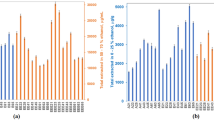Abstract
The composition and bacteriostatic activities of fifteen propolis samples from various botanic and geographic origins were determined. Twenty-six phenolic components were identified by high-performance liquid chromatography with array photodiode detector. Acacetin and apigenin were most abundant. Pinocembrin, quercetin, rutin and vanillin were present in lesser quantities. Variance analysis shows significant differences (P≤0.05) in the contents of phenols, flavonoids and active components. The minimum inhibitory concentration of propolis is about 53 times higher than that reported for tetracycline againstBacillus subtilis andStaphylococcus aureus, and about 400 times higher againstEscherichia coli.
Similar content being viewed by others
References
Hausen, B.M., E. Wollenweber, H. Senfe and B. Post,Contact Dermatitis 17:163 (1987).
Hirosato, I.,Honeybee Sci. 9:115 (1988).
Wollenweber, E.,Biochem. Syst. Ecol. 3:47 (1975).
Greenaway, W., T. Scaysbrook and F.R. Whatley,Bee World 71:107 (1990).
Vanhaelen, M. and R.J. Vanhaelen-Fastré,J. Pharm. Belg. 34:252 (1979).
Havsteen, B.,Biochem. Pharmacol. 32:1141 (1983).
Molan, P.C.,Bee World 73:62 (1992).
Scheller, S., J. Tustanowski, E. Felus and A. Stojko,Arneim. Forsch/Drug Res. 27:2342 (1977).
Balestrieri, F. and D. Marini,Riv. Ital. Sci. Aliment. 16:143 (1987).
Barberá, R., R. Farré and M.J. Roig,Anal. Bromatol. 42:345 (1990).
Marigo, G.,Analusis 2:106 (1973).
Lebreton, Ph., M. Jay, B. Voirin and M.P. Bouchez,Chemie Analyt. 49:375 (1967).
Villeneuve, F., Les composés phénoliques de la féve de cacao:Theobroma cacao L. Evolution au cours de la fermentation, Ph. D. Thesis, Université du Languedoc, Montpellier, France, 1982.
Amiot, M.J., S. Aubert, M. Gonnet and M. Tacchini,Apidologie 20:115 (1989).
Standard Methods for the Analysis of Oils, Fats and Derivatives, 7th edn., edited by the International Union of Pure and Applied Chemistry (IUPAC), Blackwell Scientific Publications, Oxford, 1987.
Bourzeix, M., M. Heredia, M.I. Estrella, J.L. Puech and K. Fartsov,Bull. Liaison “Groupe Polyphénols” 6:131 (1979).
Godefroot, M., P. Sandra and M. Verzele,J. Chromatogr. 203:325 (1981).
Vajonina, T.V., and E.S. Dushkova, inPropóleos: Investigaciones científicas y opiniones acerca de su composición. Características y utilización con fines terapéuticos, Apimondia, Bucarest, 1975, pp. 162–166.
Serra Bonvehí, J., and J. Bosch Callis,An. Quím. 85 B:38 (1989).
National Formulary (USP), Antibiotics-Microbial Assays/Biological tests. USP XXII, American Pharmaceutical Association, Washington, D.C., 1991, pp. 1488–1489.
Meresta, L. and T. Meresta,Bull. Vet. Inst. Pulawy 26:77 (1983).
Carlo Sessa S.p.A., Método analitico per propolis polvere, Laboratorio controllo qualitá, Viale Gramsci 212/224 Sesto, Milano, 1990.
Serra Bonvehí, J.,Grasas y Aceites 39:334 (1988).
Ivanov, Ts.,Animal Sci., 24:84 (1987).
Serra Bonvehí, J., and F. Ventura Coll,Estudio del propóleos y principios activos del mismo en la miel, edited by I.R.T.A., Cabrils, 1992, pp. 1–157.
Mabry, T.J., K.R. Markham and M.B. Thomas,The Systematic Identification of Flavonoids, Springer-Verlag, New York, 1970.
Verzar-Petri, G., E. Lemberkovics, Gy. Luckacs and M. Folvari,Kolortztikal Ertesitö 5–6:221 (1986).
Garrido, J.L., C. Díez de Bethercourt and E. Revilla,Anal. Bromatol. 39:69 (1987).
Kedzia, A.,Rev. Phytother. Prat. 90:4 (1990).
Author information
Authors and Affiliations
About this article
Cite this article
Bonvehí, J.S., Coll, F.V. & Jordà, R.E. The composition, active components and bacteriostatic activity of propolis in dietetics. J Am Oil Chem Soc 71, 529–532 (1994). https://doi.org/10.1007/BF02540666
Received:
Accepted:
Issue Date:
DOI: https://doi.org/10.1007/BF02540666




